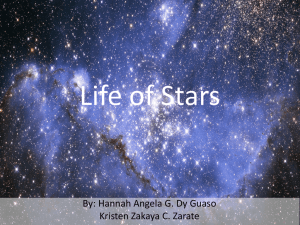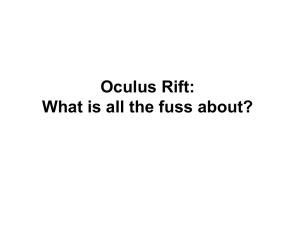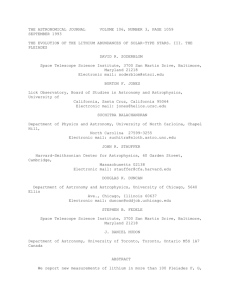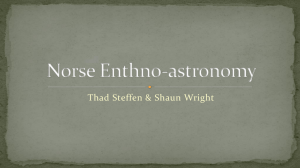Ancient Views of the Stars
advertisement
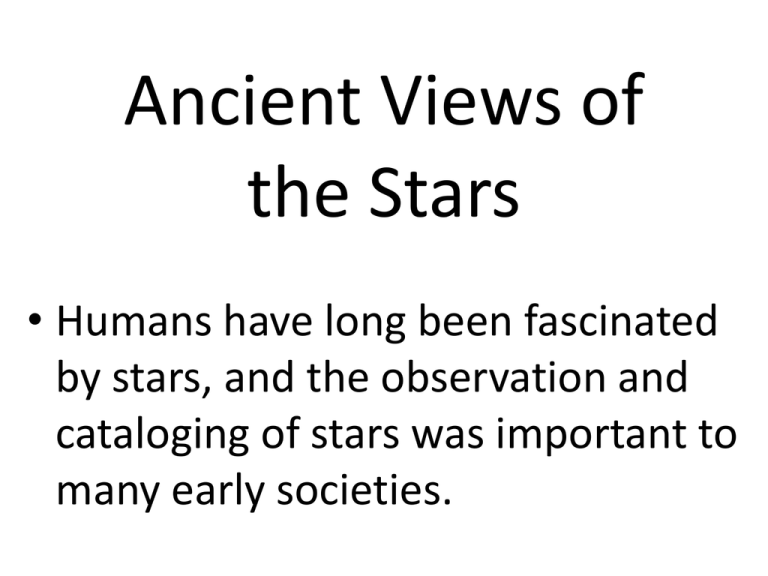
Ancient Views of the Stars • Humans have long been fascinated by stars, and the observation and cataloging of stars was important to many early societies. Egyptian • Star table from the ceiling of the tomb of Ramses VI • (Source: http://en.wikipedia.org/wiki/File:Lep sius-228-III-ramsèsVI-détail.jpg) http://members.westnet.com.au/Gary-David-Thompson/page11-18.html Part of Egyptian coffin lid showing two Egyptian astronomer's assistants and hieroglyphic list of decan stars and their positions. Babylonian • A tablet from the Enuma Anu Enlil text, containing 21 years of astronomical observations of Venus made in the first millenium BCE. • (Source: http://en.wikipedia.org/wiki/File:Venus_Tablet_of_A mmisaduqa.jpg) Mayan The Maya had an almanac that displayed the full cycle of Venus. They counted five sets of 584 days, that is 2,920 days, approximately 8 years or 5 repetitions of the Venus cycle. Dresden Codex http://www.michielb.nl/maya/venus.html Greece Anaximander’s view of the cosmos (610-546 BCE) http://en.wikipedia.org/wiki/Anaximander Greece (?) • Ptolemy, a Roman citizen of Egypt who wrote in Greek Greece (?) • Ptolemy’s Almagest contained a catalogue of stars, 1028 stars associated with 48 different groupings. • (Source: http://www.ibibli o.org/expo/vatica n.exhibit/exhibit/ dmathematics/ima ges/math09a.jpg) Greece (?) • In Ptolemy’s universe, each planet, including the sun orbited the Earth in a fixed, circular orbit. • The stars orbited in a fixed, circular orbit just beyond Saturn, and beyond the stars was the realm of God. • (Source: http://zebu.uoregon.edu/2003/hum3 99/cop2.jpg) Muslim • An astronomical observatory • (Source: http://www.muslimheritage.com/) Muslim • Astronomical table showing Sun, Moon, and Planets by Ibn alShatir • (Source: http://www.muslimheritage.com/) Muslim • Astronomical calculations from an Arabic translation of the Almagest by Ishaq bin Hunayn (830-910) and revised by Thabit bin Qurra (836-901). • (Source: http://www.muslimheritage.com/) Muslim Muhammad Salih Tahtawi of Sindh headed the task of creating a massive, seamless celestial globe using a secret wax casting method in the Mughal Empire, completed in the year 1631. http://en.wikipedia.org/wiki/Islamic_astronomy China • Tang Dynasty star map from about 700, found in the caves at Dunhuang • (Source: http://en.wikipedi a.org/wiki/File:Du nhuang_star_map. jpg) China A star map with a cylindrical projection. Su Song's star maps represent the oldest existent ones in printed form (1092 CE). http://en.wikipedia.org/wiki/Chinese_astronomy But, where do the stars come from? • Six wives (Pleiades cluster) ate wild onions that gave them skunk breath. The Husbands (Hyades cluster) threw them out of their huts. When the wives went up into the sky to live, the lonely husbands followed but never caught them. From the Mono peoples of the Sierra Nevadas http://web.archive.org/web/19981203122318/http://www.ac.wwu.edu/~skywise/legends.html#Six Wives http://en.wikipedia.org/wiki/Pleiades_(star_cluster) The Pleiades • Back when the sky was completely dark there was a chief with two sons, a younger son, One Who Walks All Over the Sky, and an older son, Walking About Early. The younger son was sad to see the sky always so dark so he made a mask out of wood and pitch (the Sun) and lit it on fire. Each day he travels across the sky. At night he sleeps below the horizon and when he snores sparks fly from the mask and make the stars. The older brother became jealous. To impress their father he smeared fat and charcoal on his face (the Moon) and makes his own path across the sky. • From the Tsimshian peoples of the Pacific Northwest http://web.archive.org/web/19981203122318/http://www.ac.wwu.edu/~skywise/legends.html#Six Wives So, what are the stars used for? • Calendars • Navigation • Religious ritual Genesis 1:14 God said, "Let there be lights in the firmament of the heavens to divide the day from the night; and let them be for signs and seasons, and for days and years." http://commons.wikimedia.org/wiki/File:Tycho_instrument_sextant_mounting_19.jpg
